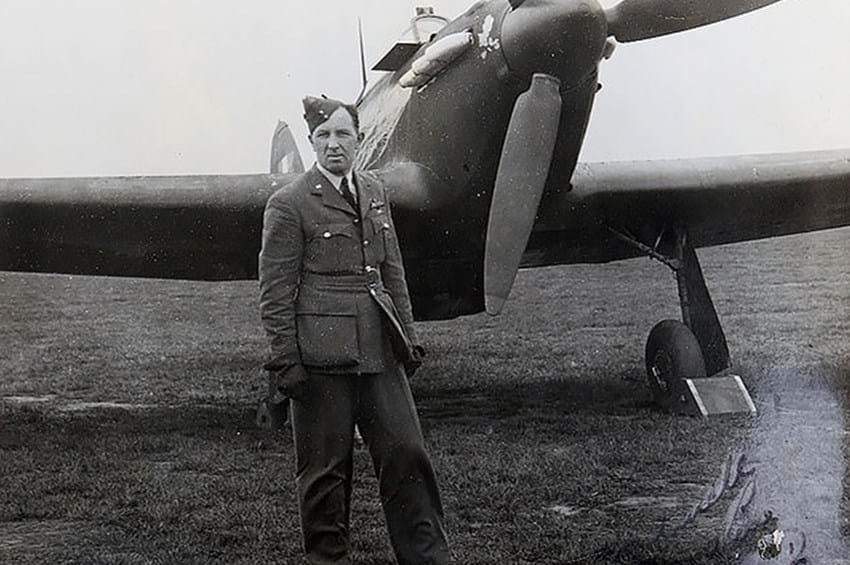Incredible story of RAF hero pilot who could see in the dark and shot down a record 14 German planes at night without radar emerges as his poignant archive goes up for auction
07/12/2020 | Matthew Tredwen

The incredible story of an RAF hero pilot who could see in the dark and shot down a record 14 German planes at night without a radar has emerged as his poignant archive goes up for auction.
Flight Lieutenant Richard Stevens' incredible ability to see in the dark meant he was the original 'Cat's Eyes' pilot of the Second World War.
Flt Lt Stevens, who claimed 14 night victories over German bombers targeting London during the Blitz, was killed in action during a sortie over Belgium in December 1941 having claimed his final victory earlier that night. He was 32.
In the 12 months before his death he was awarded the Distinguished Service Order, Distinguished Flying Cross and Bar for gallantry.
His medals remain with his family but the archive of letters, telegrams and photographs have now been consigned to auction by a military collector.
Flt Lt Stevens, from Tonbridge, Kent, worked on a cattle farm in Australia and as a policeman in Palestine before returning to Britain in the mid-1930s.
He married Mabel Hyde and was trained as a pilot ferrying aircraft with Northeast Airlines.
He joined the RAF Auxiliary Squadron in 1937 and trained on a Hurricane before being posted to 151 night-fighter Squadron at Wittering, Cambridgeshire.
A drawing by the acclaimed war artist Eric Kennington of Flt St Stevens is also part of the archive, as are a section of armoured glass from a Heinkel 111 bomber he shot down and a bit of parachute from a Junkers Ju 88 he destroyed.
It will be sold by C&T Auctions, of Ashford, Kent, for an estimated £3,000.
Flt Lt Stevens whooped with delight after claiming his first two kills on the night of January 15, 1941. He saw a Dornier 215 flying south over the London area and pursued it while unleashing fire.
The Dornier returned fire and dived down steeply but after a 15 minute chase Flt Lt Stevens shot it down.
He then flew back to the capital where he spotted a Heinkel at 17,000ft and took it out with a devastating burst from just 50 yards away, causing it to crash into the sea off Canvey Island.
His Distinguished Flying Cross citation states: 'This officer has performed outstanding work on night fighting operations during recent weeks.
'One night in January 1941, he shot down two hostile aircraft (Dornier 215 and Heinkel) in the London area.
'In both these engagements he chased the enemy over 100 miles before destroying them at extremely short range.
'In one instance he followed the enemy aircraft almost to ground level from 30,000ft.'
Military aviation historian Andy Saunders said: 'Richard Stevens had incredible night vision and the utterly remarkable ability to see in the dark.
'He was able to land at airfields covered in fog which grounded most other pilots. He operated literally with eyes in his Hurricane and just looked out for German aircraft in the darkness.'
A combat report from October 1941 in the archive reveals a daring operation where he intercepted and took out a Junkers Ju 88 off the East Anglian coast.
In his debrief, he stated: 'I gave tally-ho, I've hit him. Tally-ho he's going down. Tally-ho he hit the ground with an awful thump.'
The 'Cat's Eyes' moniker had been wrongly given by the RAF to the legendary night fighter ace Wing Commander John Cunningham.
Cunningham used radar to seek out enemy planes in the dark but the RAF couldn't let on to Germany that its pilots were using new technology so nicknamed him Cat's Eyes to throw them off.
One of the 80 documents in the archive is a letter from Cunningham in which he described Flt Lt Stevens as 'the only really successful cat's eyes night fighter pilot'.
In the letter to historian Terry Thompson in 1992, W/Cmdr Cunningham, who scored 20 victories, wrote: 'Stevens was probably the only successful night fighter who achieved his success at night solely by use of his own eyes.'
His success included shooting down two German bombers over London after chasing them 100 miles, finishing them off at close range.
Tim Harper, specialist at C&T Auctions, said: 'Everyone knows Cunningham as 'Cat's Eyes' Cunningham so for him to give such generous praise of Flt Lt Stevens in the letter tells you what an extraordinary pilot he was - both immensely brave and skilful.
'Even on his final sortie he claimed a victory over a Belgian airfield. The archive has been put together by an RAF enthusiast and it contains about 80 items.
'It is a unique and highly important record of Britain's greatest night fighter ace of the Blitz.'
Flt Lt Stevens was killed flying a Hurricane during a raid over a German aerodrome at Oostende in Belgium in December 1941.
He crashed into the ground while pursuing an enemy aircraft and was buried in the Breda Cemetery before being reburied at Bergen-Op-Zoom.
In a letter of condolence sent to Flt Lt Stevens' family he was described as a 'gallant officer' who 'contributed to us winning the war at night'.
It read: 'It was during 1941 that the great night battle of this country took place and I do not hesitate to say that the example set by the late Flt Lt Stevens and his high standard of courage and skill as a night fighter contributed towards the final defeat of the enemy at night.'
The archive also boasts various photos of his wartime service and a moving image of his grave.
The sale takes place on December 8.

